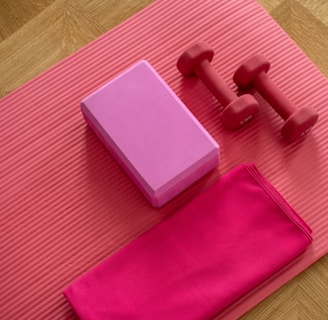Exercise - Getting Started
The basics of why and how to add regular activity to your daily life.
Jessica Collins
3/27/20254 min read


Exercise. Something that we often commit to in the same way we commit to eating healthier - once a year, we declare that we will build a new habit, we spend money on gear and/or gym memberships, and while it sticks for some people, most of us find that it is really hard to build this habit and tend to find other things to do with our time within a few months. 'Buy nothing' or local online markets are full of like-new exercise equipment starting around March every year (so if you're looking for equipment, now is the time to be on lookout).
How do we break out of this pattern and build an actual regular habit of moving more, and what type of movement should we be investing in?
First, let's revisit motivation - find your "why" and hold fast to it. Improving our health or aesthetics takes time and holding on to the reasons for eating better and moving our bodies in ways that support those end goals may not be a fast process. If your goal is medically driven, like improving your cholesterol numbers, losing weight, healing from injury or surgery, make sure your doctor is on board with your choice of activity before starting an exercise program.
As always, think things through and set yourself up for success - if you're not naturally an early bird, 5 am workouts might not be for you. If you hate being around people while you're getting your sweat on, maybe try for solo activities rather than a gym membership. If you love community, sign up for a class rather than investing in a home gym. If you're goals/deadlines driven, find an event that interests you, like a race or competition and sign up for it as something to work toward. If you're mostly sedentary and have a busy schedule that keeps you tied to a desk or commuting most of the day, build in small but regular 10-minute movement breaks throughout your day (put them on your calendar if you need to set boundaries on your time). Build on your current strength, stamina, and other physical abilities to increase your fitness level one day at a time.
If the idea of regular exercise bores you, consider trying new things that seem like they might be fun for you. Maybe think back to your childhood dreams and look for opportunities to learn to ride a horse, do karate, dance, or participate in a team sport and supplement class/practice with exercises that help you get better at the skills that will help you have more fun in class/practice. Course instructors and team coaches should have the ability to modify their program to your skills and abilities, and if you look forward to your daily dose of activity, you'll be more likely to stick to it. Get moving and stretch your limits when it feels easy, so that you keep getting better at the things you want to do more of.
What is exercise? What types of movements matter most for better health? There are 3 main categories of exercise: Cardio, Strength, and Balance/Flexibility. Many activities are a combination, but taken separately, each has its benefits, so let's take a closer look.
Cardio exercise is exercise that primarily affects your heart and lungs, and the benefits of cardio are mainly to the cardiovascular system, and the biggest thing you may notice is that you have more energy and stamina to do the things you love for longer without having to take as many breaks. Any exercise that increases your heart rate counts as cardio. Examples include: walking at a pace where you can talk but not sing, jogging/running, swimming, bicycling or hand-cycling, canoeing or kayaking, paddle boarding, skiing, dancing, playing tag with your kids or grandkids, hiking, climbing, using an elliptical machine or a stationary bike, interval training, jumping jacks - anything that keeps you in a state of motion and gets your blood pumping.
Strength conditioning is exercise that primarily affects your muscles and bones. The benefits of strength conditioning are mainly to increase strength and bone density through making normal motions a little harder with the use of resistance. Examples of strength conditioning include pushups, situps, squats, using resistance bands, using weights like dumbbells or barbells, or using cable towers. In terms of intensity, you don't have to push yourself to failure (when you can't do even one more repetition with proper form) in each workout - work at a level that is just slightly harder than the same movement without resistance. Stop when the last repetition feels like you won't be able to do another with proper form. Increase resistance when it feels too easy.
Balance and flexibility work primarily affects our proprioceptive sense (our sense of where we are in space), which helps keep us safe from trips and falls. Examples of balance and flexibility work include Pilates, some dance elements, stretching, and range of motion (ROM) work.
A well designed program should include all these elements, and there can be a lot of crossover between them. For example, someone who is lifting weights should also consider including balance and flexibility work so that they can use proper form when lifting, as it helps prevent injury. Whatever you choose for your main activity/exercise, think about whether you're getting all 3 components, and supplement whatever might be missing so that you can participate as fully as you want to for as long as it holds your interest.
A note on nutrition to support exercise; even if you're pursuing exercise as a component of weight loss, it is essential to be properly fueled for your activities. Calorie deficits should not be so great that you risk injury through exhaustion. If you need guidance along those lines, please reach out and I can help you with a plan that will support your goals.
If you're new to exercising and have any medical restrictions, a physiotherapist is a great place to start. They can teach you how to move your body safely, and how to modify exercises appropriately to work within your limitations. Once you graduate from physiotherapy, you can continue on your own or work with a certified personal trainer to further develop your exercise program.
Wellstring Nutrition and Wellness
Resources to keep your healthy lifestyle affordable.
Contact
Support
jessica@wellstringnutrition.com
(434) 222-4177
© 2025. All rights reserved.
This site may contain affiliate links
